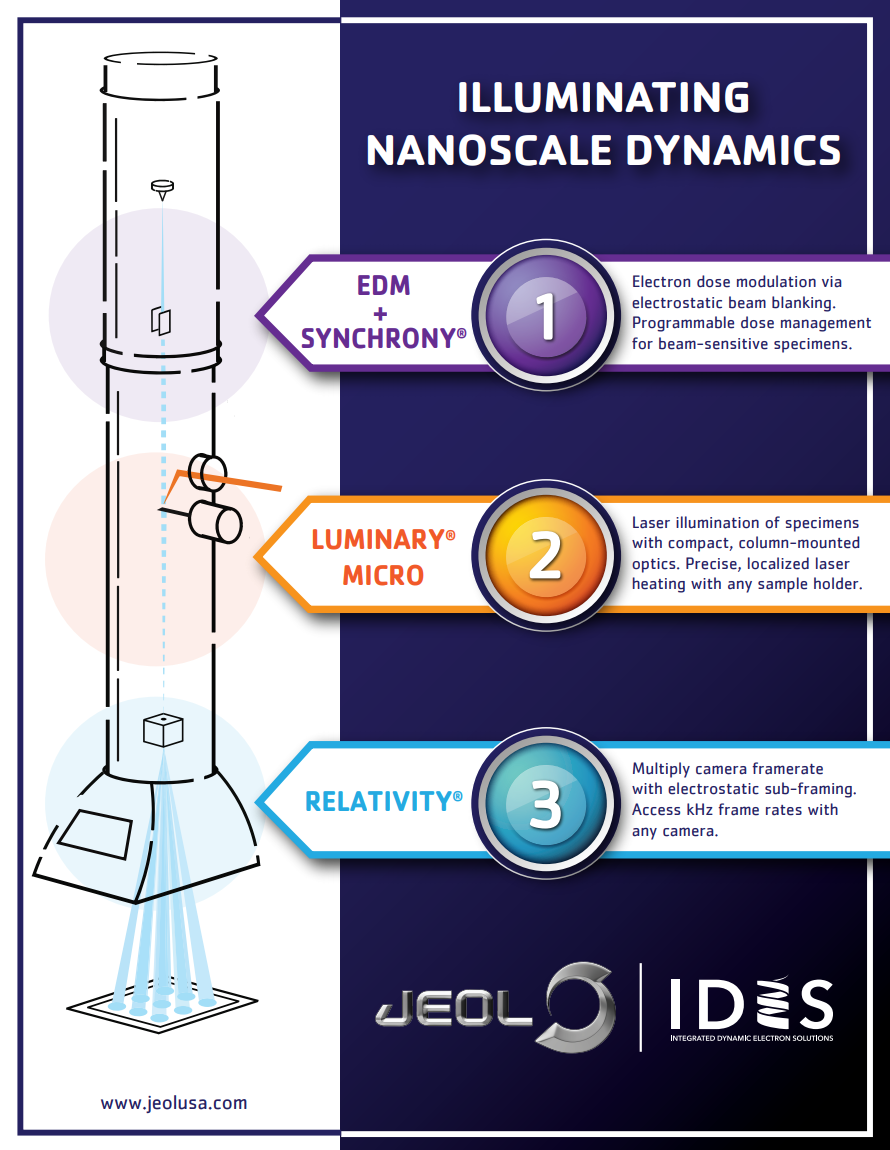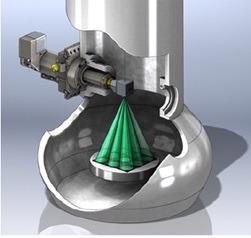Over the last decade, recent electron microscope advancements have created new ways in which to push the boundaries of what is possible with regards to resolution in transmission electron microscopes (TEM) in both imaging and microanalysis modes.
While it is becoming customary to conduct static experiments at atomic and sub-atomic resolution scales, the emergence of dynamic investigations in (S)TEM is fast becoming more urgent and vital. Users desire rapid evaluation while capturing in-situ changes and reactivity of specimens at nanosecond scale.
Integrated Dynamic Electron Solutions, Inc. (IDES) has been a long-established leader in the field of time-resolved transmission electron microscopy, innovating a wide range of technological solutions and improvements to both ultrafast and dynamic TEM.
Since the early-2020 acquisition of IDES by JEOL Ltd., several other complementary technologies have been developed and released – a number of which will now be appropriate for release into the wider fields of analytical and in situ scanning/TEM (S/TEM).
This article focuses on three products that will significantly enhance the functionality and flexibility of a microscope relative to beam damage mitigation and control, optical illumination and speed.
Significantly, as these attributes can mostly be retrofitted onto existing JEOL columns, it is conceivable to extend the capabilities of an in-service microscope in a simple way.

Image Credit: JEOL/IDES.
EDM
The electrostatic dose modulator (EDM) is made up of an electrostatic shutter which facilitates both rapid beam blanking and in-situ dose control. With EDM, it is possible to achieve beam switching times faster than 20 ns, symbolizing a 105x increase in beam blanking speed compared to that of a traditional magnetic shutter.
As EDM is positioned just below the gun, dose attenuation takes place instantly and without negatively impacting the imaging conditions; thus, it is not necessary to commit to optical realignments and the subsequent S/TEM images exhibit no impact of the dose modification: a pulsed beam STEM illumination is displayed in Fig. 1.
During a single STEM scan, the illumination ratio is attenuated from 90% to 50% while sustaining atomic resolution.
Additional features, including STEM synchronization and True Area Scan for EDS acquisition, allow programmable dose structuring while limiting any undesired specimen irradiation. In summary, EDM presents extremely tunable probe conditions with precision nanosecond timing.
![Pulsed Beam STEM Imaging demonstrated with 500 kHz frequency on Si[110] at 300 kV with a pixel dwell time of 19 us/pixel (1024 x 1024 pixels). The duty ratio is changed on the fly during the scan from 90% to 50%. Note that at 500 kHz, the beam is pulsing on/off 10 times per pixel.](https://www.azom.com/images/Article_Images/ImageForArticle_20514_16240110733492051.jpg)
Figure 1. Pulsed Beam STEM Imaging demonstrated with 500 kHz frequency on Si[110] at 300 kV with a pixel dwell time of 19 us/pixel (1024 x 1024 pixels). The duty ratio is changed on the fly during the scan from 90% to 50%. Note that at 500 kHz, the beam is pulsing on/off 10 times per pixel. Image Credit: JEOL/IDES.
Luminary Micro
Luminary Micro is a compact specimen photoexcitation system that converts a JEOL column into a laser-based dynamic TEM. It preserves complete functionality of a traditional S/TEM without loss of image resolution.
Luminary Micro presents extremely localized specimen illumination to evaluate laser-induced phenomena and dynamic processes at the microsecond timeframe with continuous or pulsed wave operation.
Its close focusing, FWHM < 40 um, enables a dramatic reduction in specimen drift throughout heating processes, which is due to the localized nature of the heating source.
Relativity
Relativity, an electrostatic sub-framing system mounted through a wide-angle accessory column-port, allows traditional imaging cameras to capture kHz scale frame rates. The schematic diagram (Fig. 2) shows how Relativity swiftly deflects the beam onto user-defined subframes of an existing microscope camera.
For instance, with a 30 fps 4k camera, 4x4 mode achieves 400 fps @ 1kx1k pixels per frame, when moving to 16x16 mode gets to an extraordinary 7680 fps @ 256x256 pixels per frame: ideal for 4D-STEM and ptychography applications.
Effective frame rates in excess of 10kHz can be acquired on a single camera exposure when selecting triggered burst mode. Relativity actualizes truly rapid in situ microscopy at a reasonable cost compared to exclusive high-speed solutions such as pixelated detectors.

Figure 2. Schematic representation of the electrostatic deflector (Relativity). The deflector subdivides a conventional camera into user-defined regions to enable high-speed imaging capabilities. Image Credit: JEOL/IDES.
It is crucial to note that the three aforementioned components are completely complementary and combining them offers the user total, ultra-precise control of temporal and spatial domains while imaging, spectroscopy and in situ experiments are performed.
Due to the overall compact and unobtrusive nature of each IDES component, when not in use, these components still allow easy access to more conventional S/TEM applications while retaining the microscope's inherent high-performance specifications and capabilities.

This information has been sourced, reviewed and adapted from materials provided by JEOL USA, Inc.
For more information on this source, please visit JEOL USA, Inc.